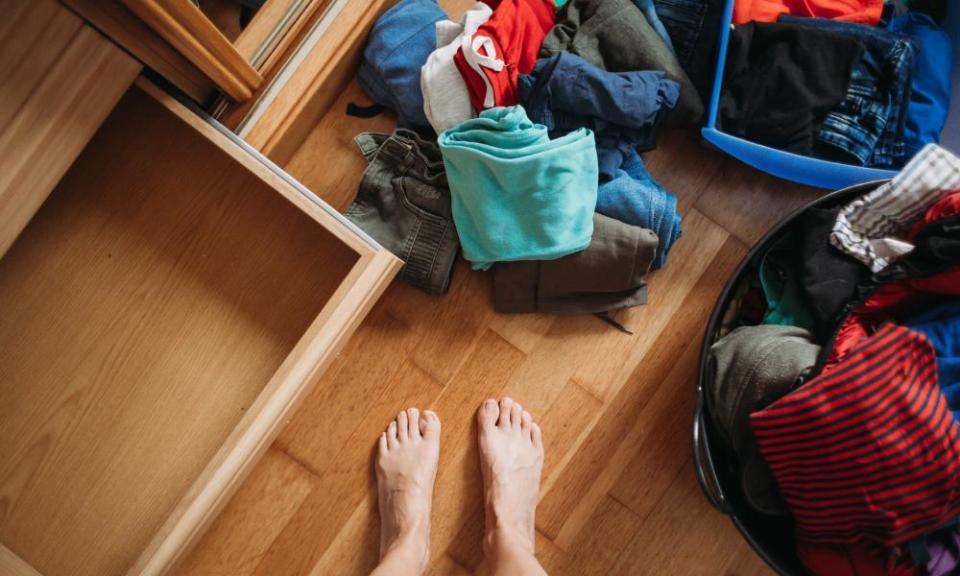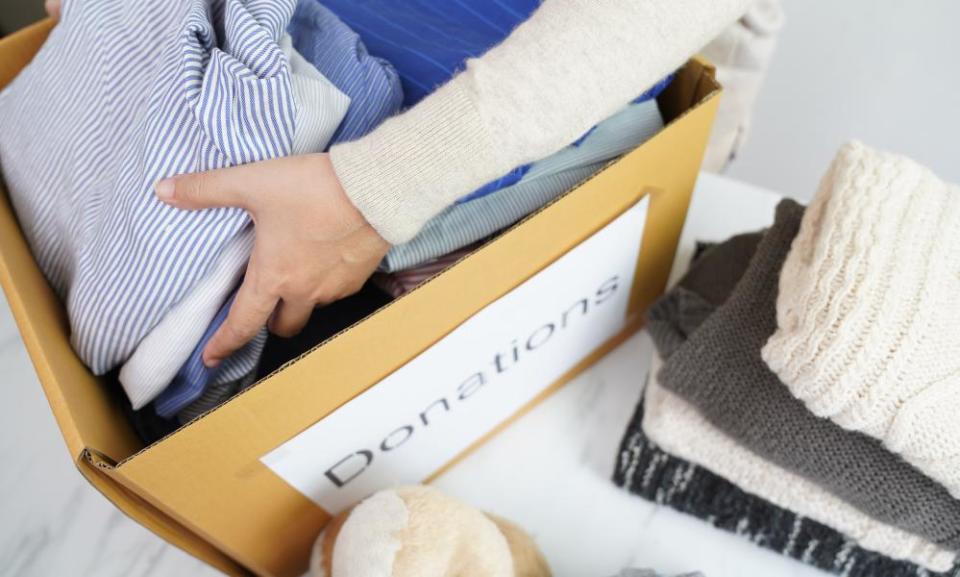‘Get the biggest cardboard box you can find …’ How to declutter your home as lockdown eases

Now that we’ve all had more than a year of staring at nothing but the inside of our own homes, it’s becoming very apparent that we own far too much stuff. But, while a household clearout is a good idea in theory, it’s one that usually requires a bit of a run-up. If you’re struggling to get started, here are some expert tips.
Why declutter?
“You wake up in the morning, you tumble out of bed,” says Dilly Carter, professional declutterer and the star of BBC One’s Sort Your Life Out. “You try to find a towel, you try to find your toothbrush. You go to the wardrobe, you try to find a shirt that’s been ironed. You try to find a pair of trousers. Your socks are in the kitchen drawer. You stumble down the stairs, trip over some Lego, go to the kitchen, sniff the milk to see if it’s off. And you start work and you’re like, ‘Why am I so stressed?’” This build-up of tiny annoyances is why you need to declutter, she says.
Start with an empty room
“The reason a room has become chaotic is because so many things have come into there that weren’t supposed to be there,” says Carter, who also offers one-hour decluttering sessions online. “The only way we can change that is by starting again.” Carter recommends emptying a room before decluttering and laying out all your items in your garden, if you have one. “An artist would never create a masterpiece by drawing over another masterpiece, would they?” she adds. The next trick is to put back only the things you absolutely need. Be as ruthless as you can; the goal is to create as much space as possible. “We don’t want to be surrounded by stuff, because stuff clouds our mind and clouds our judgment,” says Carter. “We need space to breathe.”
Reclaim the room
Another tactic that Carter is fond of is to remember what each room is supposed to be for. “Sometimes a kitchen is a kitchen, but it can also be a playroom, and it’s also a study, and it’s also a front room. That’s why the kitchen doesn’t feel like a kitchen at the moment,” she says. “So let’s bring it back to just being a kitchen. Let’s take out all the kid’s toys and put them back in the bedroom.” You will end up with dedicated spaces that don’t feel encroached upon by the rest of the house. “It’s about giving every room its own identity. Even in our front room, there’s kid’s toys everywhere and that drives me wild, because I’m trying to sit down and watch Line of Duty and all I can see is Peppa Pig.”
Take photos
Nothing will help you identify areas of progress like photos, says Begum Zarmann, TaskRabbit UK’s decluttering trend expert. “Before you start to declutter, choose a small part of your home, like a bathroom cabinet, and take a photo of it. Once you have tidied and organised that space, take an after photo.” Why? “Keeping a record of your transformations gives you the motivation to declutter more.”

Use boxes
Zarmann suggests sorting all your stuff into four boxes. “Label them ‘rubbish’, ‘give away’, ‘keep’ or ‘relocate’,” he says. “Whether it’s a drawer or a full room you’re tackling, the key is to organise your items into one of the four boxes and to not skip a single item, no matter how insignificant you may think it is.” Carter, meanwhile, suggests getting one big box for your paperwork. “Walk around your house with the biggest cardboard box you can find and just shove it all in there,” she says. “Doesn’t matter if it’s unopened mail, paperwork or files. Whatever it is, get it all into one box. Because then, mentally, you are only dealing with one box. And then when you’re ready to deal with that box, you sit there, in front of your favourite TV show, and you can start going through that paperwork. From that, you will soon have your keep pile, your burn pile, your shred file.”
Where to put your stuff
Getting rid of your decluttered stuff will take some forward thinking, especially during a period of lockdown. “You can send off for donation bags, or Music Magpie will send you a box that you fill up with DVDs and send off. You need to pre-plan, but there are lots of different things that you can do to donate,” says Carter. She also recommends Olio, an app that allows users to share food waste and household items with local people for free. Charity shops in England will have reopened for in-person donations, but if you have items that are only good for the tip then you’ll still need to plan ahead – some authorities now require you to book a time slot.
However, you might have bigger items that you would prefer to sell. If it’s furniture, eBay is your friend. If it’s clothing, try Vinted or Depop. But when selling something online, be sure to list it properly. “Be clear and to the point,” says Vinted’s brand director, James Peach. “The photo will be the main selling point for your product, so ensure that it’s high quality and visually appealing,” he says. “Also, provide images that display the product from different perspectives in order to give the potential buyer a rounded view of what they are buying.” Finally, if you’re not sure how much to charge, he suggests “taking a look at the cost of similar items that are selling, in order to make sure you’re being reasonable”.

 Yahoo Finance
Yahoo Finance 